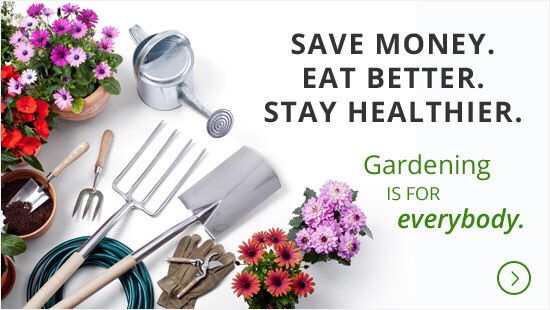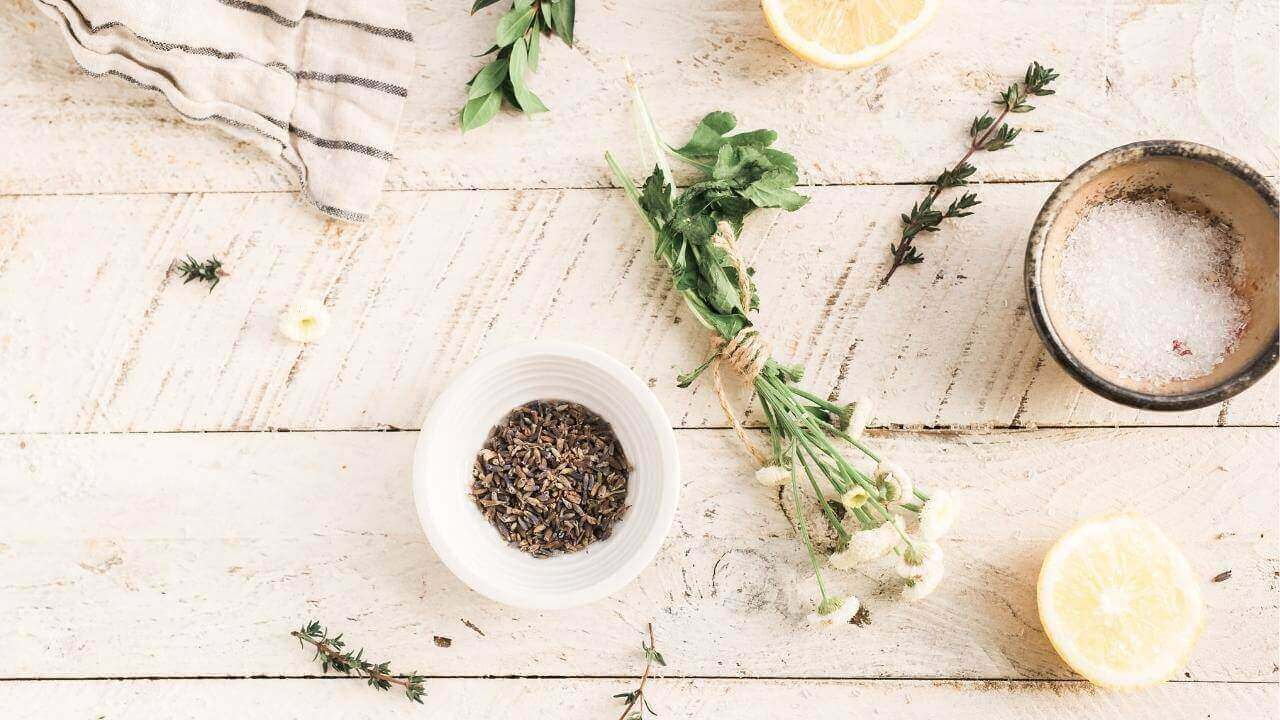Hi! Welcome to my Indoor Garden Ideas round-up post!
I compiled my favorite indoor gardening tips anyone can start to implement today to get their indoor garden all set and ready to grow. These are transcripts from live gardening teachings that will help you take your indoor garden to the next level.
Table of Contents
How to Grow Herbs Indoors
What’s first?
My favorite: herbs!
Yes, you can grow herbs on your window sill in your kitchen or another place in your house, which is where our indoor garden ideas are going to start! Window sills are a great place to start plants that you’ll later move outdoors. Lighting is key.
My 3 favorite herbs to grow indoors with window sill gardening in containers are:
- Basil – I love the taste of basil in Italian dishes like this homemade slow-cooker lasagna or this allergy-friendly bruschetta.
- Thyme – So delicious, I give this herb center-stage in my tomato salad recipe.
- Parsley – More than just a pretty garnish, parsley makes our list of superfoods, which is why I include it in my cleansing juice recipe!
Be sure you pick up non-GMO, heirloom herb seeds for the best quality! We recommend Seeds for Generations.
How to Grow Herbs Teaching Transcript
Window Sill Gardening (Part 1)
Thank you for joining us for our Abundant Life Tidbits. I’m Mama Z. And today we’re going to talk about part 1 of window sill gardening.
The first thing that we’re going to talk about is lighting. This is normally a regular light. But it is a grow light. They cost about $5 a month if you leave it on 24 hours a day. And they go for 2 months if you leave them on only during the nighttime.
The second thing we’re going to talk about is what I have on my window sill. I use the 3 favorite herbs that we use in our kitchen almost on a daily basis. We have basil, thyme, and parsley. So I recommend putting your favorite plants there. And we transition them because they are not going to get as much light as they do outside. So what I do is I have them each stay in for about 2 months, and then I transition them to outside, which takes about a week. And then I put new plants in.
The third thing that I use for my window sill garden is any of the fruit that has fallen off during the process of picking or has fallen off because of watering or rain. And I let it come in. And I let it finish ripening so you do not have to waste it in the refuse pile.
Thank you for joining us for our Abundant Life Tidbits. Also please join us for part 2 of Window Sill Gardening: Rooting and Planting Plants.
Rooting Plants for Indoor Gardening
Next, on our indoor garden ideas tour is how to root plants…
How to Root Plants Teaching Transcript
Window Sill Gardening (Part 2)
Welcome to the Abundant Life Tidbits. I’m Mama Z. And today we’re going to take part 2 of our series, Window Sill Gardening. Today we’re going to talk about rooting from clippings.
I have fresh clippings of spearmint and thyme. And those both will root. You need to change the water out every day. And if after a week you don’t have any roots that appear, then you need to throw those away and cut a new clipping.
You’ll want to change the water out every day. And then after about a month, you should have enough roots in the bottom of your cup that you are able to transition to dirt, just like this. So you’re going to want to use each clipping in its own pot.
And then we’re going to go to the next part of our series and transitioning it to outside. Thank you for joining us for Abundant Life Tidbits. We hope you and your family enjoy the abundant life!
How to Root from Hydroponics
Now that you know the basics of rooting plants indoors, our indoor gardening ideas take us to hydroponics…
Rooting from Hydroponics Teaching Transcript
Welcome to part 3 of Window Sill Gardening with the Abundant Life Tidbits. I’m Mama Z. And today we’re going to talk about rooting from hydroponics.
If you’ve ever had the best-tasting basil from Whole Foods or from your farmer’s market, and it was in a root clump done by a hydroponic and you thought, “I wish I could duplicate that at home,” you can.
Make sure you don’t use all of the basil that’s on the plant. And you will want to put the root clump in a glass of water, changing it out every day. Once the roots have filled the entire cup, then you are going to transition to dirt.
So each and every sprig will need its own dirt. And then once you do that, we’ll have to then transition to outside. Join me in the next lesson as we root a pineapple.
Rooting a Pineapple Indoors
Our #4 indoor gardening idea helps you grow a pineapple plant from the top of your pineapple (in any climate!).
Pineapples take a while to grow, but they are truly fascinating plants that are worth the time and effort. And, you’re starting the plant from something you’d normally throw away or compost. Win! It’s the perfect way to use a pineapple after making a beautiful fruit basket or homemade sweet and sour chicken.
You’ll need the top of a pineapple, some rooting hormone, a fresh cup of water, and a bit of time. Eventually, you’ll need some dirt and a pot to put the pineapple outside.
Rooting a Pineapple Teaching Transcript
Welcome to part 4 of Window Sill Gardening. I’m Mama Z. And today we are going to talk about rooting a pineapple.
You’ll want to take your pineapple and cut off the top, cutting off every bit of fruit that’s left because any bit of fruit that’s left is going to rot your rooting plant. So once that is off, then you’re going to wet it.
And take a little bit of rooting hormone. Shake off the rest. And then you’re going to set it in a fresh cup of water. You’re going to change up that water every day. And then about after a week, you should start seeing some of the roots grow.
You’re going to want to wait until all the roots fill around the entire pineapple. And this could take a little bit of time. But keep putting fresh water in every day. And then you will eventually see that.
Once you have that, then we’re ready to transition to dirt. And this pot won’t be there very long, but this is the pot that we will transition to outside. Then once it is transitioned to outside, it will go in a nice aerated bucket. And that will be its final resting place.
With the rest of your pineapple, make sure you turn it upside down. Wait 24 hours so that the sweet end and the sour end will mix flavors. And it will be the best-tasting pineapple you’ve had at your table. Now join me in our next part where we take this plant and the rest of our plants and transition them to being outside. We hope and pray that you and your family enjoy the abundant life.
How to Transition Plants Outside
Last we need to talk about how to transition plants from the window sill to the outdoors. This is something a lot of people rush, but we don’t want to do that!
It’s hard on the plants!
Transition Plants Outside Teaching Transcript
Window Sill Gardening (Part 5)
Welcome to the Abundant Life Tidbits. I’m Mama Z. And today we’re going to talk about part 5, our last in the series of Window Sill Gardening.
We’re going to be talking about transitioning your indoor plants to outside. We do that in 4 phases. We do that in:
- Shade
- Part shade
- Part sun
- Full sun
We’re going to start off with the first phase, which is shade. We’re going to take the plants that we used in the previous series and transition them to outside. In the first part with shade, you’re going to look for an area of your house that is fully shaded, like under a deck, the shadiest side of your house, or in this case, because the sun rises over here and goes over this way, I’ve utilized this table and its glass and leg to protect the plants.
Next we are on to phase 2. Phase 2 is part shade. It is also important to keep those plants there 3 to 5 days. So you could put them next to, but not in full sun, under the deck, right at the edge where the sun is coming in. Or you could do like what I did, where it’s still protected by this table and its top. But it still gets a good, full ray of sun, but it’s not too hot.
Now we’re onto phase 3, which is part sun. Part sun is a little bit sunnier than part shade. And as you can see from these plants, they are still protected by the top of the table. But now they’re not protected by the base of the table. You can achieve this by having them out in front of your deck so it is getting sun. But maybe it’s not only getting full sun, it’s getting part of the day. So either morning sun or afternoon sun, but not both.
After 3 to 5 days in part sun, then we’re going to move to the last phase, which is full sun. From this point, they can either stay in full sun or be planted directly in the ground. As you can see, the plants that we’ve been transitioning are right here. They are completely open to the sun. And they can hit both morning through afternoon sun. Then we are ready to plant.
Thank you for joining us in our five-part series on window sill gardening. We hope you and your family enjoy the abundant life.
Learn More About Organic Gardening with Our Masterclass! See all my secrets for non-toxic landscaping with my Organic Gardening Masterclass - only for Bible Health Academy Members!













